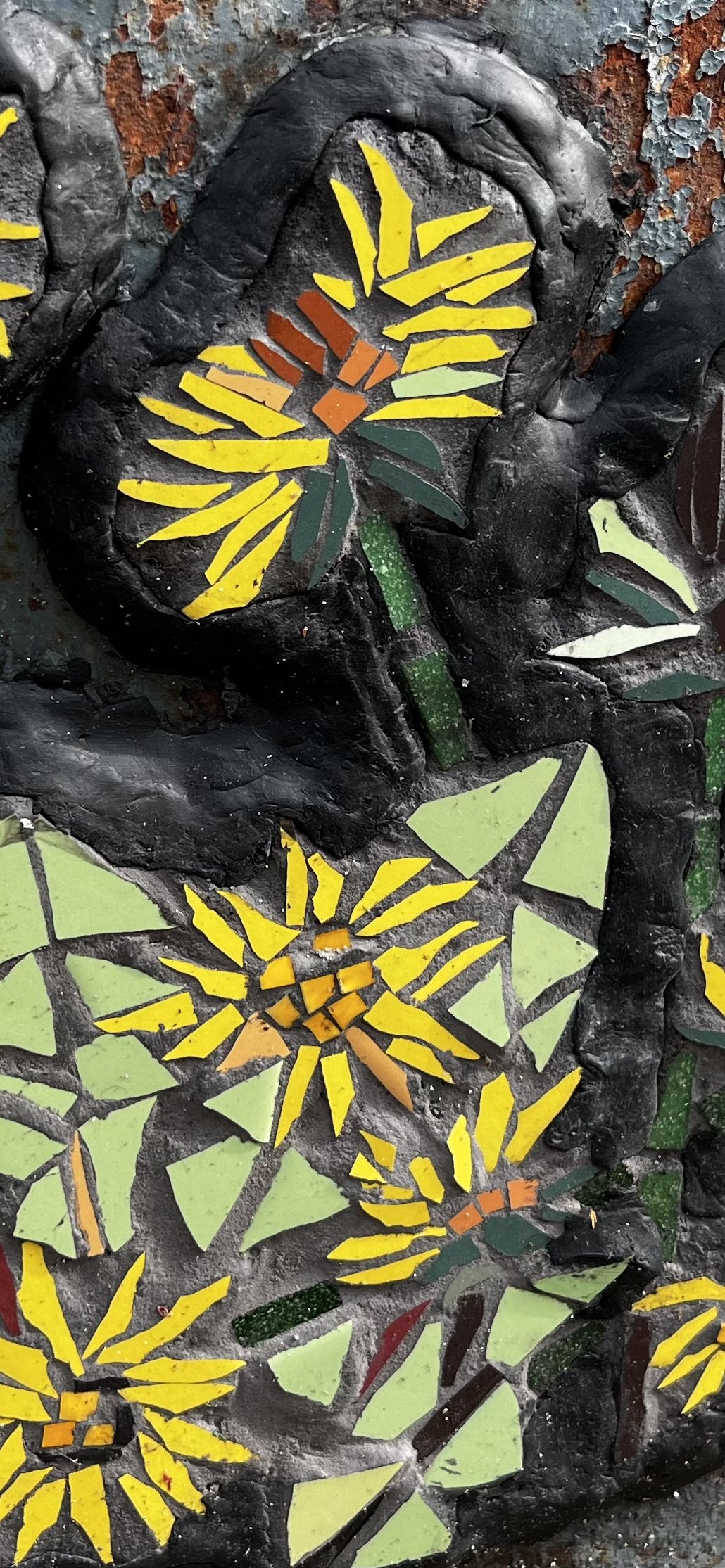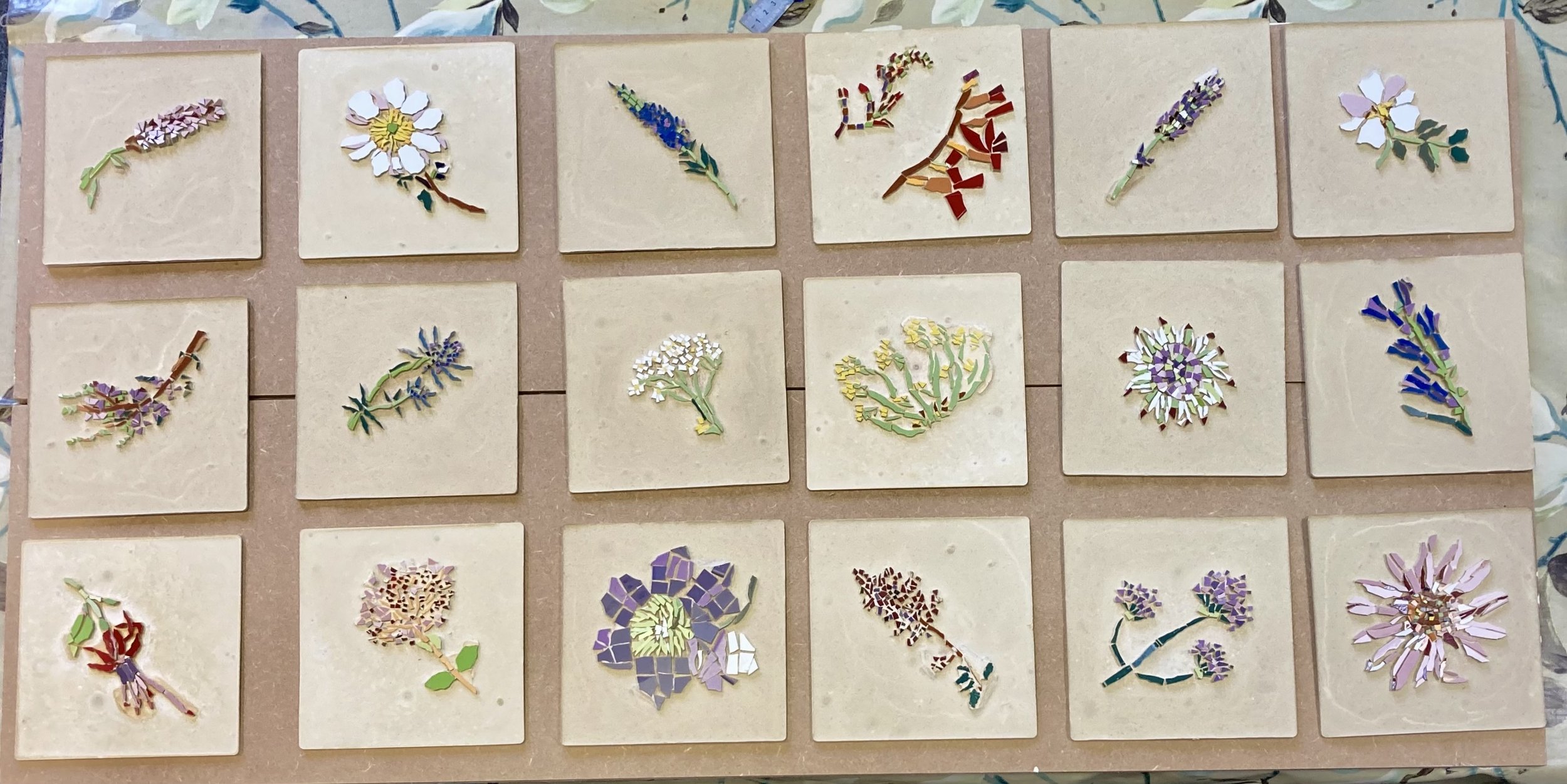
Dalcross Street
SARA JANE MELVILLE
I am a Contemporary Mosaicist, Landscape Designer and fiddler. I left work in 2020 to pursue my dream of doing mosaics full time. I have a studio in Whiteinch where I make and teach. All my work is inspired by nature, landscape and geology and particularly lichens, mosses and flowers My main work theme is the importance of peatland restoration for carbon capture. I use primarily recycled, foraged and found materials. I am regularly engaged for workshops, sessional work and take commissions. I am very keen to pursue making mosaic street art to enhance more urban areas.
About the Artist
The Proposal
In 2023 I did the //100daysprojectscotland and made a sketch mosaic flower every day for 100 days. I was very excited to apply for Outside the box as I grew up in the West End. My idea was to make a small mosaic trail of Scottish native flowers up Byres Road. I wanted to connect each flower to each street or box and so did site visits, took measurements, looked at the condition and colour of box, existing features such as graffiti and adjacent uses.
The Final Product
Dandelions for Dalcross Street
Dandelions are everywhere and when open look so cheery and sun like. I liked the idea of linking to the big Sun newspaper advert above the Newsagents. I also spoke to staff in Shepherds solicitors and one member had worked there for 7 years and looked out the window at the blank boxes! She asked for something cheery. Locally there are loads of self- seeded buddleias in the brownfield site beside Dalcross Pass. I noticed there are harebell like motifs on the close tiles.
For my design I wanted to represent the different stages the plant goes through. They have very small flowers collected together into a composite flower head. Each single flower in a head is called a floret. Dandelions are one of the most vital early spring nectar sources for a wide host of pollinators. The flower heads mature into spherical seed heads sometimes called clocks.
Interesting facts - The entire plant, including the leaves, stems, flowers, and roots, is edible and nutritious, with nutrients such as vitamins A and K as well as calcium and iron.
It has been a Western tradition for someone to blow out a dandelion seedhead and think of a wish they want to come true.
Sara has placed some extra wildflowers next to our other art works up and down Byres Road. Can you find our other wee hidden gems?
A wee secret extra…
Fraoch, ‘Calluna Vulgaris’ - Heather
There has always been a strong Gaelic community in Partick and so I thought heather was fitting to represent the Highlands & Islands.
Interesting facts: Heather is an important food source for sheep and deer which can graze the tips of the plants when snow covers low growing vegetation. Heather was used to stuff beds and make brooms, which is how it got its Latin name. Calluna is a word meaning 'to beautify', or 'to sweep'.
Cirsium Vulgare - Spear Thistle
I found that 'blessed thistle' is an ale served in Tenants. Our native thistle isn’t used in brewing but I thought fitted the bill for this box!
The spear thistle has flower heads with bright pink florets (tiny flowers) and a ball of spiny bracts (leaf-like structures). It’s leaves are grey-green and spiny, and its tall stems are winged, spiny and cottony. Despite its 'weed' status, the seeds of the Spear thistle are attractive to birds like goldfinches and the flowers are a nectar source for butterflies like the small copper.
Its classic thistle appearance - purple, fluffy-looking flowers sitting atop a spiny ball - may well have given rise to the Scottish national emblem. This is what our Scottish national flower really looks like.
Campanula rotundifolia - Harebell - Scottish Bluebell flowers are a favourite with many people. Their flowers are very delicate and nod happily in a breeze This was a harder to represent than other flowers using my limited colour palette of ceramic tiles. I love the combination of purple and dark green and am happy this fits so well alongside the bright greens of the work by Agnes.
Myosotis sylvatica Forget me Knots
Glasgow Flower Club meet in the nearby Botanic Gardens and exist to encourage students and those new to Glasgow to come, meet others and work in the garden. Members learn to sow seeds, care for flower beds and bunch the flowers which are donated to Shelter in Great Western Road. The first bunches this year were full of Forget Me Knots. I noticed that locals look after the large plant pots in Vinicombe street. The Scottish charity Social Bite have their annual Tree of Giving event here for the homeless.







